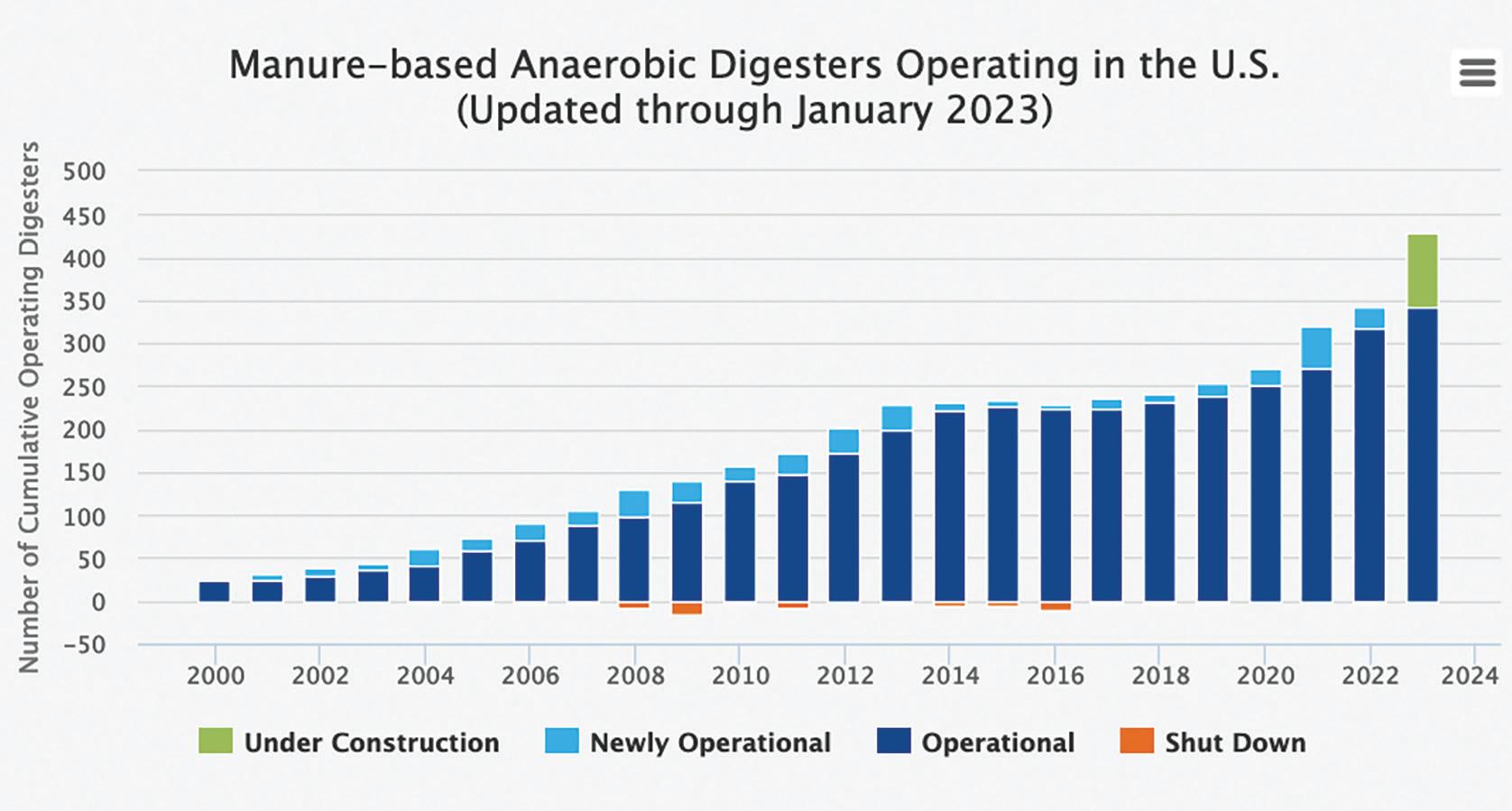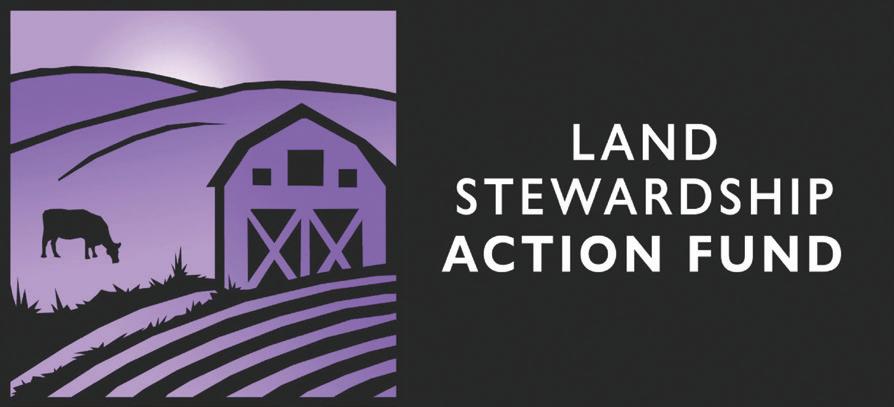
7 minute read
Digesting the Facts on Digesters
Making Methane from Manure Raises Environmental, Economic Concerns
By Martin Moore & Laura Schreiber
Advertisement
Manure has long been a highly beneficial source of fertility for crops, as well as a way to build healthy soil. If not properly managed, however, manure can have significant negative impacts on water quality, air quality, and soil. In concentrated animal feeding operations (CAFOs), where thousands of head of livestock are kept in centralized barns, millions of gallons of manure are produced. Typically, manure from these large operations is stored in a manure lagoon or pit in liquid form and then later fieldapplied. However, if manure is applied above agronomic rates, on frozen fields, or before a rain event, it can run off into lakes and streams.
In such situations, a valuable source of fertility suddenly becomes a waste disposal problem. Agricultural runoff pollutes water with nitrates and phosphorus, leading to negative health impacts for humans and wildlife. When manure is collected in lagoons or pits without access to oxygen, creating an anaerobic setting, it causes the release of methane, a highly potent greenhouse gas with more than 80 times the climate warming impact of carbon dioxide over the first 20 years after it is released, according to the United Nations Environment Programme.
Manure management on a large scale is costly. According to the Institute for Agriculture and Trade Policy, in 2020 alone Minnesota farmers received $6.9 million in USDA Environmental Quality Incentives (EQIP) funding to help pay for manure lagoon covers, manure waste disposal, and more. That’s over 25% of the total EQIP funding Minnesota farmers received that year.
According to the Environmental Protection Agency, manure accounts for 11% of agriculture’s greenhouse gas emissions. It’s clear a better solution to manure management is necessary.
Digester Proposals in the Midwest
In 2023, communities across Wisconsin and Minnesota learned of proposals claiming to solve our region’s manure problem. One company, Nature Energy, a Danish subsidiary of Shell Oil, proposed to build large scale, anaerobic manure digesters in Minnesota communities such as Paynesville,
Of the 343 methane digesters operating in the United States as of January 2023, 290 were on dairies and 46 were on hog operations, according to the EPA. The remaining are located on poultry and beef operations.
Digesters are not economically viable without government subsidies. The American Biogas Council and many biofuel companies have spent significant time lobbying for federal subsidies to be included in the recently passed Inflation Reduction Act and incentivized through other programs such as EQIP, REAP (Rural Energy for America Program) and more, according to the Reuters news service. Federal dollars typically cover up to 40% of the costs to build a digester, according to the University of CaliforniaDavis. A typical on-farm digester can cost close to $1.2 million to build, according to University of Missouri Extension.
The second major form of public support for digesters is a carbon credit system where companies generating “renewable natural gas” can get subsidies from states and the federal government. According to a database developed by North Carolina State University, there are 96 financial incentives for digesters, such as property tax reductions, corporate tax credits, loan programs, grant programs, and performance-based incentives.
Benson, Sauk Centre, Lewiston, and Wilson Township (Winona County), as well as in New Richmond, Wis. These proposals came as a surprise to the communities and left residents asking several questions.
At each facility proposed by Nature Energy, the company would collect manure from a 30-mile radius and mix it with food waste and crop residue. The resulting slurry would be pumped into large airtight chambers where anaerobic microbes would break down the slurry and release a mixture of methane and carbon dioxide gas, called biogas. After the biogas is “cleaned” to remove the carbon dioxide, the remaining methane would be sent directly to municipal gas grids or used to keep the digester system running. Finally, the leftovers from this process would produce an end product called digestate, which can be solid or liquid. Solid digestate is typically used as animal bedding while liquid digestate can be transported back to farmers for field application as a fertilizer.
Every taxpayer dollar spent subsidizing digesters is a dollar that is not being spent on regenerative agriculture practices such as cover cropping, no-till, and managed rotational grazing. These practices build soil health and the demand for program dollars already far exceeds the supply of funds available to support such techniques. Between 2010 and 2020, just 31% of farmers who applied for EQIP funding and 42% who applied to CSP were awarded contracts, according to an analysis by the Institute for Agriculture and Trade Policy.
Because of economies of scale, larger producers benefit more from the construction of digesters, says the USDA’s Economic Research Service. If more of our public resources go to larger corporate digester companies and the largest CAFOs, then less will be available to small and medium-sized farmers. This disparity will continue to drive smaller farmers off the land. As CAFO own-
Digester, see page 9…
…Digester, from page 8 ers chase methane digester subsidy funds, this will incentivize the production of more liquid manure, increasing the potential for leaks and air pollution. Ironically, a system that is billed as a solution to our manure problem could lead to making it even worse.
The Impacts
There are a number of environmental concerns related to manure digesters, ranging from increased ammonia and nitrous oxide emissions, to increased wear and tear on roads and dust pollution, to possible spills or even explosions, according to Penn State University and reporting in the Milwaukee Journal.
When studies make the claim that digesters “reduce the amount of greenhouse gasses emitted,” they are comparing the amount of greenhouse gasses from a digester to the emissions that would otherwise come from the manure management practices of large factory farms. This is not the case of a methane digester on a CAFO providing a net gain in the battle to reduce greenhouse gas emissions. Much of the methane produced by a 7,000-cow dairy would not be there in the first place if it wasn’t for the fact that it relied on a massive liquid manure system. A problem was created by this system and now the public is being asked to pay for solving it on massive operations that only make this, and numerous other environmental and economic problems, worse
Making Manure a Soil Builder
There are viable alternatives that help make manure what it should be — a valuable source of soil-building fertility.
For example, managed rotational grazing utilizes perennial pastures growing grasses and forbs to provide low-cost feed for livestock such as cattle. Because rotational grazing spreads manure evenly across the landscape and relies on deep-rooted, perennial plants, it can sequester large amounts of greenhouse gasses, according to research in Wisconsin that was recently reported on in the Proceedings of the National Academy of Sciences.
Anaerobic digesters are only a viable option for non-pastured based animal systems where cattle are concentrated in centralized barns and the manure can be collected into a pit/lagoon. A recent EPA “Inventory of U.S. Greenhouse Gas Emissions and Sinks” report describes how, when manure is “handled as a solid” and deposited on pasture, it spent on regenerative agriculture practices. tends to decompose aerobically, producing little or no methane. In a nutshell, the report is describing why livestock production systems that rely on rotational grazing of cattle or straw bedding for hogs are a climatesmart way to raise animals.
What Now?
In August 2023, citing rising costs and variable “green gas” prices, Nature Energy and Shell Oil announced they were pausing all projects in Minnesota and Wisconsin. For now, this is good news for local communities, the environment, and taxpayers’ dollars.
In September, the Land Stewardship Project organized an informational event in Lewiston in southeastern Minnesota’s Winona County. Given the economic and political tailwinds behind these projects, combined with the large number of communities in the Upper Midwest that are close to methane gas pipelines as well as the vast quantities of manure being produced by CAFOs, members in Winona County are concerned that more proposals will be coming in the near future.
Over 40 community members attended the Lewiston event to hear from experts who spoke on topics ranging from the claims made by digester supporters to what it’s like to live next to a large-scale digester. Discussions at the event revealed deep concerns from attendees about the risks posed to our rural communities for the benefit of large corporations like Shell Oil.
LSP will continue to monitor this situation and organize local community members who have concerns about these and other corporate-backed projects that benefit a handful of Big Ag special interests. p
Martin Moore and Laura Schreiber are LSP policy organizers. If you would like to receive more information or get involved with LSP on the methane digester issue, contact Moore at mmoore@ landstewardshipproject.org.
Reporting Anti-Competitive Behavior in Minnesota
In Minnesota and across the country, increasing attention is being drawn to the animal agriculture industry and the anti-competitive practices that are being used to benefit a small minority of people along the food supply chain.
Minnesota has antitrust rules that, when enforced, make it possible for people to combat monopoly power. When these rules are enforced, it is typically through a lawsuit brought by the Attorney General or a legal team. But in order to act, state officials need to hear directly from farmers who are being impacted by anti-competitive behavior.
To share your story with the Minnesota Attorney General’s office and/or the chair of the Minnesota Senate Agriculture Committee, Sen. Aric Putnam, see LSP’s web page at landstewardshipproject.org/ anticompetitiveness. For more information, contact organizer Matthew Sheets at msheets@landstewardshipproject.org or 612-767-9709.
Want to Have a Policy Impact? Connect with Land Stewardship Action Fund
In February 2018, the Land Stewardship Project’s board of directors created the Land Stewardship Action Fund (LSAF), a 501(c)(4) partner organization, because they recognized the power that comes with being able to drive forward the mission and goals of LSP with an expanded set of political and electoral tools.
LSAF came out of the realization that our members and leaders could no longer sit on the sidelines in the current political environment, but instead must proactively engage in elections so that we have a say in who is elected and representing us.
For more information on LSAF and to get involved in such initiatives as voter education and deep canvassing, see landstewardshipaction.org or contact Emily Minge at eminge@landstewardshipaction.org, 612-400-6353.









